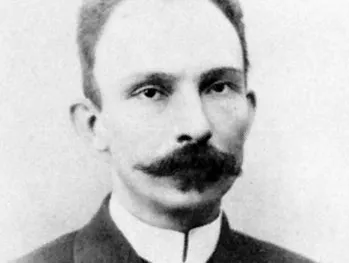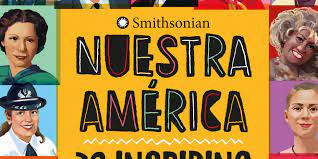5.3 “Nuestra América” – José Martí
7 min read•june 18, 2024
Sylvia Rodriguez
AP Spanish Literature 💃🏽
24 resourcesSee Units
"Nuestra América" is an essay written by José Martí. Martí advocates for Latin American independence and unity as well as harmony from outside influence and powers. Martí's work is a very important piece in the movement for Latin American identity and the culture around politics.
Context Behind “Nuestra América” José Martí
Author Background
José Martí was a Cuban poet, essayist, and journalist who is considered one of the most important figures in the Latin American literary and political movements of the late 19th century. He was a leading voice in the struggle for Cuban independence from Spain, and he dedicated much of his life to fighting for the rights of the oppressed and marginalized in Cuba and throughout the Americas.

Image Courtesy of Britannica
Time and Place
📜Historical: Martí's essay first appeared in the late 19th century in South America, when the continent was still struggling to recover from colonialism and gain independence. The region's goals and difficulties in defining its identity and asserting its autonomy are reflected in this text.
🗺️Geographic: Martí's concept of "Nuestra América" emphasizes the geographic unity and shared history of the entire South American continent. He emphasizes the diversity of the region's landscapes, climates, and natural resources, all of which have a significant impact on the cultural, social, and economic development of the area.
Societal Context
👑Political: Martí wrote "Nuestra América" at a time when political unrest raged throughout Latin America, and numerous nations were battling issues of authoritarianism, corruption, and outside interference. In his essay, he urges the nations of Latin America to reject outside pressures and construct democratic and just governments in order to advance the idea of a continent that is united and autonomous.
🧑🏽🤝🧑🏻Socio-economic: Martí's essay discusses the socio-economic inequalities that are pervasive in Latin America, with a particular emphasis on resource exploitation and the marginalization of indigenous populations. In his appeal for a more equitable allocation of resources and opportunities, he places a strong emphasis on the value of social justice and education in creating a prosperous and welcoming community.
🎭Cultural: "Nuestra América" honors Latin America's rich cultural legacy, which includes native customs, European influences, and African contributions. Martí emphasizes the necessity of valuing and embracing this cultural diversity since he sees it as a source of power and cohesion for the area. His essay encourages a rejection of cultural imperialism and a cultural awakening.
Need to Know About “Nuestra América”

Image Courtesy of National Museum of the American Latino
"Nuestra América" does not have an established cast of characters. Instead, it shares Martí's thoughts, views, and understanding of Latin America's political, cultural, and historical setting. The essay does not emphasize on particular people or stories, but rather, it focuses on the collective identity of Latin America.
Literary Terms and Devices
Some of the literary devices Martí uses in his essay include:
- Metáfora (Metaphor): To express his ideas and evoke imagery in "Nuestra América," Martí uses metaphors. He emphasizes Latin America's potential strength and awakening as a united continent by, for instance, symbolically comparing it to a sleeping giant.
- Símil: Martí enhances his descriptions and highlights particular facets of Latin America by using similes. His comparison of the numerous nations in the area to diamonds in a crown emphasizes their distinctive features and contributions to the collective identity of "Nuestra América."
- Símbolo: To represent more abstract ideas, Martí uses symbols throughout the text. For instance, he sees Latin American indigenous cultures as examples of resilience and resistance to colonial oppression.
- Metonimia: By using specific nations or historical persons to symbolize more general concepts, Martí uses metonymy. He uses José de San Martin and Simón Bolvar, for instance, as metaphors for the Latin American independence movement.
- Hipérbole: Martí uses exaggeration to highlight the importance and potential of Latin America. He uses overblown rhetoric to emphasize the urgency of the situation and the enormous potential of the area.
- Tono: "Nuestra América" has a passionate and persuading tone. Martí writes urgently, stressing the significance of Latin American unification and freedom.
- Antítesis: Martí uses antithesis to draw attention to differences and oppositions. He draws a contrast between Latin America's hardships and its aspirations, pitting imperialism's repressive powers against the continent's potential for liberation.
- Paradoja: Martí uses paradox to clarify difficult concepts. He proposes the paradoxical idea, for instance, that Latin America has enormous potential for development and transformation despite its difficulties and external challenges.
Summary of “Nuestra América”
"Nuestra América" is a seminal essay by José Martí that reflects his vision for a united and independent Latin America. In the essay, Martí critiques the cultural and intellectual dependence of Latin America on Europe and the United States, and he calls for a new form of identity and solidarity based on the shared heritage and experiences of the region. Martí argues that Latin America must embrace its own cultural and intellectual traditions in order to achieve political and social liberation, and he calls on Latin Americans to unite in the struggle for independence and self-determination. The essay is characterized by its poetic language, its emphasis on cultural identity and resistance, and its call to action for Latin Americans to take control of their own destiny.
Martí's essay is divided into three parts: "Nuestra América," "Patria," and "América Latina." In the first part, Martí describes the challenges facing Latin America and the need for a new form of identity and solidarity based on shared experiences and heritage. In the second part, he discusses the concept of "Patria," or homeland, and argues that Latin Americans must work towards the common goal of achieving political and social independence. In the third part, he expands his vision to include all of Latin America and calls for a pan-Latin American movement that transcends national borders.
The significance of "Nuestra América" lies in its influence on the development of Latin American identity and nationalism. Martí's ideas helped to inspire a generation of Latin American intellectuals and activists who were working towards independence and self-determination. The essay also reflects the broader cultural and political trends of the time, including the rise of anti-colonial and anti-imperialist movements around the world. Today, "Nuestra América" is widely studied and celebrated as a classic of Latin American literature and a powerful call to action for social and political liberation.
Furthermore, Martí emphasizes the importance of education and intellectual development in the struggle for liberation. He sees education as a key tool for empowering Latin Americans and creating a new cultural identity. He advocates for the creation of universities and intellectual centers that are independent of European and American influence, and he stresses the importance of education in the development of a strong and independent Latin America. In addition, Martí addresses the issue of race and ethnicity in Latin America, and he argues that the region's diversity should be celebrated and used as a source of strength in the struggle for liberation.
Themes in “Nuestra América”
Las sociedades en contacto
Martí focuses on the outcomes of interactions between various societies in Latin America. In his investigation of the connections between native peoples, European conquerors, and African slaves, he emphasizes the cultural fusion and hybridity that resulted from these contacts.
El imperialismo
Martí is extremely critical of imperialistic nations. He argues against imperialism and the necessity to uphold the independence and sovereignty of the area while denouncing the exploitation and dominance of Latin America by outside powers.
El nacionalismo y el regionalismo
Martí calls for harmony in Latin America between nationalism and regionalism. He stresses the significance of preserving a sense of national identity while honoring and promoting the cultural diversity and distinctive qualities of various regions across the continent. Martí contends that regional autonomy and self-expression may coexist with Latin American nationalism and cooperation.
Significance of “Nuestra América”
"Nuestra América" is a seminal work in the history of Latin American literature and political thought. Martí's vision of a united and independent Latin America has had a profound impact on the region's cultural and political landscape, and his call for cultural and intellectual resistance to imperialism and domination remains relevant today. The essay has been widely studied and analyzed, and it continues to inspire Latin Americans to fight for their rights and their cultural heritage. Martí's legacy can be seen in the works of many other Latin American writers and thinkers who have been inspired by his ideas.
Martí's emphasis on cultural identity and resistance to imperialism has also had a significant impact on the development of Latin American nationalism. His call for Latin Americans to unite in the struggle for independence and self-determination has influenced many nationalist movements throughout the region, and his ideas have helped to shape the political discourse around issues of sovereignty and independence.
Furthermore, "Nuestra América" has had an impact beyond the realm of literature and politics. It has become a cultural symbol of Latin American identity and resistance, and it continues to inspire artists, musicians, and activists throughout the region. Martí's vision of a united and independent Latin America remains a powerful and enduring symbol of hope and possibility for millions of people.
Browse Study Guides By Unit
🏇Unit 1 – La época medieval
🛳Unit 2 – El siglo XVI
🖌Unit 3 – El siglo XVII
🎨Unit 4 – La literatura romántica, realista y naturalista
🤺Unit 5 – La Generación del 98 y el Modernismo
🎭Unit 6 – Teatro y poesía del siglo XX
🌎Unit 7 – El Boom latinoamericano
🗣Unit 8 – Escritores contemporáneos de Estados Unidos, y España

Fiveable
Resources
© 2025 Fiveable Inc. All rights reserved.